
Rhea [REE-a] is the largest airless satellite of Saturn. It was discovered in 1672 by Giovanni Cassini. Rhea is an icy body with a density of 1.33 gm/cm3. The low density indicates that it is composed of a rocky core taking up less than one-third of the moon's mass, with the rest composed of water-ice. Rhea is somewhat similar to Dione. They both have similar composition, albedo features, varied terrain and synchronous rotations. The temperature on Rhea is -174°C (-281°F) in direct sunlight and between -200°C and -220°C (-328°F and -364°F) in the shade.
Rhea is heavily cratered with bright wispy markings. Its surface can be divided into two geologically different areas based on crater density. The first area contains craters which are larger than 40 kilometers (25 miles) in diameter. The second area, in parts of the polar and equatorial regions, has craters under 40 kilometers (25 miles) in diameter. This suggests that a major resurfacing event occurred some time during its formation.
| Rhea Statistics | |
|---|---|
| Discovered by | Giovanni Domenico Cassini |
| Date of discovery | 1672 |
| Mass (kg) | 2.49e+21 |
| Mass (Earth = 1) | 4.1667e-04 |
| Equatorial radius (km) | 765 |
| Equatorial radius (Earth = 1) | 1.1994e-01 |
| Mean density (gm/cm^3) | 1.33 |
| Mean distance from Saturn (km) | 527,040 |
| Rotational period (days) | 4.517500 |
| Orbital period (days) | 4.517500 |
| Mean orbital velocity (km/sec) | 8.49 |
| Orbital eccentricity | 0.0010 |
| Orbital inclination (degrees) | 0.35 |
| Escape velocity (km/sec) | 0.659 |
| Visual geometric albedo | 0.7 |
| Magnitude (Vo) | 9.7 |
| Maximum surface temperature | -174°C |
| Minimum surface temperature | -220°C |
 Animation of Saturn's Moon Rhea
Animation of Saturn's Moon Rhea
This animation of Saturn's moon Rhea was created from a global map
created using images taken during flybys by NASA's Cassini spacecraft.
Images from NASA's Voyager mission fill the gaps in Cassini's coverage.
(Copyright Calvin J. Hamilton)
See also the Rhea Map Image & Rhea Equal-Area Mosaics.
 Rhea: Full Moon
Rhea: Full Moon
This giant mosaic reveals Saturn's icy moon Rhea in her full,
crater-scarred glory.
This view consists of 21 clear-filter images and is centered at 0.4 degrees south latitude, 171 degrees west longitude.
The giant Tirawa impact basin is seen above and to the right of center. Tirawa, and another basin to its southwest, are both covered in impact craters, indicating they are quite ancient.
The bright, approximately 40-kilometer-wide (25-mile) ray crater seen in many Cassini views of Rhea is located on the right side of this mosaic (at 12 degrees south latitude, 111 degrees west longitude). See PIA07764 for a close-up view of the eastern portion of the bright, ray crater.
There are few signs of tectonic activity in this view. However, the wispy streaks on Rhea that were seen at lower resolution by NASA's Voyager and Cassini spacecraft, were beyond the western (left) limb from this perspective. In high-resolution Cassini flyby images of Dione, similar features were identified as fractures caused by extensive tectonism.
Rhea is Saturn's second-largest moon, at 1,528 kilometers (949 miles) across.
The images in this mosaic were taken with the Cassini spacecraft
narrow-angle camera during a close flyby on Nov. 26, 2005. The images
were acquired as Cassini approached the moon at distances ranging from
79,190 to 58,686 kilometers (49,206 to 36,466 miles) from Rhea and at a
Sun-Rhea-spacecraft, or phase, angle of about 19 degrees. Image scale in
the mosaic is 354 meters (1,161 feet) per pixel.
(Courtesy NASA/JPL/Space Science Institute)
 Sleek Rings, Rugged Moon
Sleek Rings, Rugged Moon
Rhea floats below the innermost regions of Saturn's amazing rings. This
view of the Saturn-facing hemisphere of Rhea (1,528 kilometers, or 949
miles across) allows a glimpse of the wispy terrain that covers the
trailing hemisphere of Rhea.
The image was taken in visible light with the Cassini narrow-angle camera
on Oct. 9, 2005, at a distance of approximately 1.9 million kilometers
(1.2 million miles) from Rhea and at a Sun-Rhea-spacecraft, or phase,
angle of 51 degrees. The image scale is 12 kilometers (7 miles) per pixel.
(Courtesy NASA/JPL/Space Science Institute)
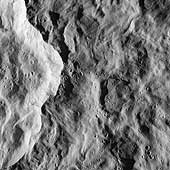 Catch that Crater
Catch that Crater
In the nick of time, the Cassini spacecraft snapped this image of the
eastern rim of Saturn's moon Rhea's bright, ray crater. The impact event
appears to have made a prominent bright splotch on the leading hemisphere
of Rhea (see PIA06648). Because Cassini was traveling so fast relative
to Rhea as the flyby occurred, the crater would have been out of the
camera's field of view in any earlier or later exposure.
The crater's total diameter is about 50 kilometers (30 miles), but this rim view shows details of terrains both interior to the crater and outside its rim. The prominent bright scarp, left of the center, is the crater wall, and the crater interior is to the left of the scarp. The exterior of the crater (right of the scarp) is characterized by softly undulating topography and gentle swirl-like patterns that formed during the emplacement of the large crater's continuous blanket of ejecta material.
Numerous small craters conspicuously pepper the larger crater's floor and much of the area immediately outside of it. However, in some places, such as terrain in the top portion of the image and the bright crater wall, the terrain appears remarkably free of the small impacts. The localized "shot pattern" and non-uniform distribution of these small craters indicate that they are most likely secondary impacts -- craters formed from fallback material excavated from a nearby primary impact site. Because they exist both inside and outside the large crater in this image, the source impact of the secondary impacts must have happened more recently than the impact event that formed the large crater in this scene.
This is one of the highest-resolution images of Rhea's surface obtained during Cassini's very close flyby on Nov. 26, 2005, during which the spacecraft swooped to within 500 kilometers (310 miles) of the large moon. Rhea is 1,528 kilometers (949 miles) across and is Saturn's second largest moon, after planet-sized Titan.
The clear filter image was acquired with the wide-angle camera at an
altitude of 511 kilometers (317 miles) above Rhea. Image scale is about 34
meters (112 feet) per pixel.
(Courtesy NASA/JPL/Space Science Institute)
 Craters, Craters Everywhere
Craters, Craters Everywhere
Craters within craters cover the scarred face of Saturn's moon Rhea in
this oblique, high-resolution view of terrain on the moon's western
hemisphere.
A large, degraded crater lies at the center, filled with rolling mounds and many smaller craters. A couple of linear depressions are visible in the terrain (especially at lower right), possibly marking tectonic faults. The crater is about 90 kilometers-wide (56-miles) and is located at 8.5 degrees south latitude, 154.9 west longitude. The moon's icy regolith, or loose surface material, has likely been pummeled into a fine powder over the eons.
This is one of the highest-resolution images of Rhea's surface obtained during Cassini's close flyby on Nov. 26, 2005, during which the spacecraft swooped to within 500 kilometers (310 miles) of the large moon. Rhea is 1,528 kilometers (949 miles) across and is Saturn's second largest moon, after planet-sized Titan.
The clear filter image was acquired with the wide-angle camera at an
altitude of 620 kilometers (385 miles) above Rhea. Image scale is about
85 meters (280 feet) per pixel.
(Courtesy NASA/JPL/Space Science Institute)
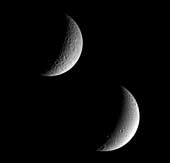 Seeing Double
Seeing Double
Saturn's sibling moons, Rhea and Dione, pose for the Cassini spacecraft in
this view.
Even at this distance, it is easy to see that Dione (below) appears to have been geologically active in the more recent past, compared to Rhea (above). Dione's smoother surface and linear depressions mark a contrast with Rhea's cratered terrain.
Sunlit terrain seen on Rhea (1,528 kilometers, or 949 miles across) is on the moon's Saturn-facing hemisphere. Lit terrain on Dione (1,126 kilometers, or 700 miles across) is on that moon's leading hemisphere. North is up.
The image was taken in visible light with the Cassini spacecraft
narrow-angle camera on Nov. 1, 2005, at a distance of approximately 1.8
million kilometers (1.1 million miles) from Rhea and 1.2 million
kilometers (800,000 miles) from Dione. The image scale is 11 kilometers
(7 miles) per pixel on Rhea and 7 kilometers (4 miles) per pixel on Dione.
(Courtesy NASA/JPL/Space Science Institute)
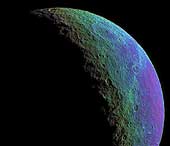 Intense Color on Rhea
Intense Color on Rhea
This intense false-color view highlights and enhances color variations
across the cratered and cracked surface of Saturn's moon Rhea.
To create the false-color view, ultraviolet, green and infrared images were combined into a single black and white picture that isolates and maps regional color differences. This "color map" was then superposed over a clear-filter image. The origin of the color differences is not yet understood, but it may be caused by subtle differences in the surface composition or grain sizes making up the icy soil.
This view shows terrain on the trailing hemisphere of Rhea (1,528
(Courtesy NASA/JPL/Space Science Institute)
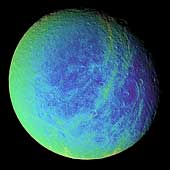 Rhea's Wisps in Color
Rhea's Wisps in Color
Bright, wispy markings stretch across a region of darker terrain on
Saturn's moon Rhea. In this extreme false-color view, the roughly
north-south fractures occur within strips of material (which appear
greenish here) that are a different color from the surrounding cratered
landscape.
To create the false-color view, ultraviolet, green and infrared images were combined into a single black and white picture that isolates and maps regional color differences. Most of the large-scale variations in brightness across the surface are removed by this process. This "color map" was then superimposed over a clear-filter image.
The origin of the color differences is not yet understood, but it may be
caused by subtle differences in the surface composition or grain sizes
making up the icy soil.
Wispy markings were seen on the trailing hemispheres of both Rhea and
Dione in images taken by NASA's Voyager spacecraft, and were hypothesized
by some researchers to be the result of material extruded onto the surface
by ice volcanism. Cassini's earlier revelation of the braided fractures on
Dione led to speculation that Rhea's wisps might also be created by
fractures.
(Courtesy NASA/JPL/Space Science Institute)
 Great White Splat
Great White Splat
Looking closely at Saturn's moon Rhea during a somewhat distant flyby,
Cassini provides this view of what appears to be a bright, rayed and
therefore relatively young crater. This crater was also observed by
Cassini at much lower resolution in the fall of 2004 and in spring of
2005. Rhea is 1,528 kilometers (949 miles) across.
For comparison, viewing the same crater near the terminator (the line between day and night) would highlight the crater's topography (vertical relief), compared to its brightness, which is highlighted in this view where the Sun is at a higher angle.
North on Rhea is up and rotated about 15 degrees to the left. This view shows principally the leading hemisphere on Rhea.
The image was taken in visible light with the Cassini spacecraft
narrow-angle camera on April 14, 2005, at a distance of approximately
247,000 kilometers (153,000 miles) from Rhea and at a Sun-Rhea-spacecraft,
or phase angle of 70 degrees. Resolution in the image is 1 kilometer (0.6
mile) per pixel.
(Courtesy NASA/JPL/Space Science Institute)
 Rhea in Natural Color
Rhea in Natural Color
The trailing hemisphere of Saturn's moon Rhea seen here in natural color,
displays bright, wispy terrain that is similar in appearance to that of
Dione, another one of Saturn's moon. At this distance however, the exact
nature of these wispy features remains tantalizingly out of the reach of
Cassini's cameras.
At this resolution, the wispy terrain on Rhea looks like a thin coating painted onto the moon's surface. Cassini images from December 2004 (see PIA06163) revealed that, when seen at moderate resolution, Dione's wispy terrain is comprised of many long, narrow and braided fractures.
Images taken using red, green and blue spectral filters were combined to
create this natural color view. The images were acquired with the Cassini
spacecraft narrow angle camera on Jan. 16, 2005, at a distance of
approximately 496,500 kilometers (308,600 miles) from Rhea and at a
Sun-Rhea-spacecraft, or phase, angle of 35 degrees. Resolution in the
original image was about 3 kilometers (2 miles) per pixel. The image has
been rotated so that north on Rhea is up.
(Courtesy NASA/JPL/Space Science Institute)
 Rhea: Polar View
Rhea: Polar View
Like the rest of Rhea's surface, the southern polar region of this Saturn
moon has been extensively re-worked by cratering over the eons. This
close-up shows that most sizeable craters have smaller, younger impact
sites within them. Near the left lies an intriguing gash.
The largest well-defined crater visible here is an oval-shaped impact toward the upper right. The crater is 115 by 91 kilometers (71 by 57 miles) in size.
Cassini acquired this view during a distant flyby of Rhea (1,528 kilometers, or 949 miles across) on July 14, 2005.
The image was taken in visible light with the Cassini spacecraft
narrow-angle camera at a distance of approximately 239,000 kilometers
(149,000 miles) from Rhea and at a Sun-Rhea-spacecraft, or phase, angle
of 56 degrees. The image was obtained using a filter sensitive to
wavelengths of infrared light centered at 930 nanometers. The image scale
is about 1 kilometer (0.6 miles) per pixel.
(Courtesy NASA/JPL/Space Science Institute)
 Amazing Icy Moons
Amazing Icy Moons
A scene straight out of science fiction, this fantastic view shows, from
left to right, Saturn's moon's Mimas, Dione and Rhea, on the far side of
Saturn's nearly edge-on rings.
The trailing hemispheres of all three moons are sunlit here, and wispy
markings can be seen on the limbs of both Dione and Rhea. The diameter of
Mimas is 397 kilometers (247 miles), Dione is 1,118 kilometers (695 miles)
and Rhea is 1,528 kilometers (949 miles).
(Courtesy NASA/JPL/Space Science Institute)
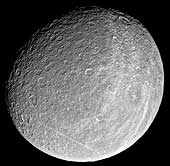 Impact Central
Impact Central
This view of the trailing hemisphere of Saturn's moon Rhea shows the
region's bright wispy markings, but also shows off the moon's craters in
great detail. Of particular interest to imaging scientists is the
distribution and orientation of the many craters with polygonal rims.
These are craters with rough, angular shapes, rather than smooth,
circular ones. Rhea is 1,528 kilometers (949 miles) across.
(Courtesy NASA/JPL/Space Science Institute)
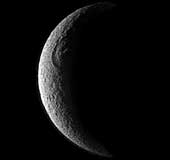 Crescent Image of Rhea
Crescent Image of Rhea
This crescent image of Rhea was acquired by Voyager 1
as the spacecraft was retreating from the moon after
closest approach. A large canyon can be seen along the
day/night terminator.
(Copyright 2002 Calvin J. Hamilton)
 Helene
Helene Titan
Titan